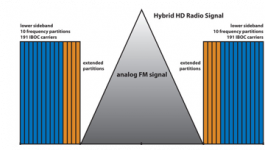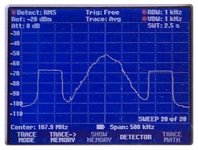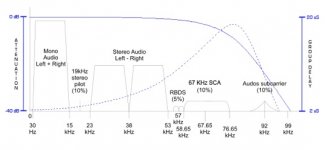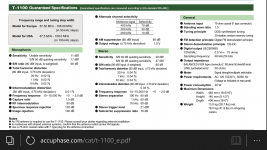Why a US market radio for Canada, which doesn't receive the US digital broadcasts, and never implemented it for domestic radio (because DAB)?
The American HDRadio/IBOC system is running on a few Canadian major market stations under an experimental license from ISED. Eventually it will almost certainly get full approval. Cars sold in Canada, unbeknownst to their owners, regularly come with IBOC tuners. I use a Sangean HDT-20 in Toronto.
People with cheap kitchen radios might not notice the sound problems with DAB (although some of them will) but most of them will complain about the unreliability ("it only works if I put it on that particular spot by the window").
Most of the people I know don't notice when the radio is on or off.
The American HDRadio/IBOC system is running on a few Canadian major market stations under an experimental license from ISED. Eventually it will almost certainly get full approval. Cars sold in Canada, unbeknownst to their owners, regularly come with IBOC tuners. I use a Sangean HDT-20 in Toronto.
Lord, I hope not. The quality is so bad that even ordinary Americans hate it. In the car, your reception constantly is shifting from HD to Analog and back again, with noticeable changes in Sound Quality (SQ) and stereo/mono reception. No thank you.
Mercifully I am not in "a major market" and, as Jack Nicholson said to Shirley MacLean, rather than move to one, "I'd rather stick pencils in my eyes". Can you somehow convince the rest still living in Toronto to stay there and quit moving to Saskatchewan? Much appreciated.
I am not so convinced that HD radio will come to Canada. There is no real value in reselling such a small amount of spectrum to the cellphone companies, so the incentive to Government isn't there. In other words, someone is going to have to lobby for it, and I don't see broadcasters or consumers behind any push, so hopefully the idea will die a deserving death.
And that coming from someone who actually owns an HD-compatible receiver. But I also own a McIntosh MR-74. And it works just fine, thank you (with a bonus: a good AM section). We have about 8 FM stations here in Saskatoon, with half of them decent broadcast quality, two are exceptional, and even the blatantly commercial ones don't sound as bad as I've heard elsewhere. [What do you need for "New Country", anyway?]
I can see it coming to southern Ontario, maybe, but there was never any DBS stations outside that market either, when that was the rage, save for a couple of stations in Montreal and Vancouver.
Last edited:
The existing spectrum allocated to FM Broadcasting in Canada runs from 76~108MHz, allowing for 100 analog channels (and therefore room for an additional 100 HD radio channels, as these broadcast on the analog sideband at about -20dB down from the analog level). None the less, the commercial radios receive only 88~108 MHz.
I don't know this for a fact but I assume the "missing" 76~88 MHz spectrum is used for commercial subscription broadcasts such as Muzak, which I do know come via FM.
Doing a little research, it seems these "experimental" HD radio licenses were made available in 2008, almost a decade ago. Yet no-one seems to be aware of them (save for a few enlightened souls in The Centre Of The Universe). That pre-dates the shutdown of the DAB system by about three years.
All the licenses are in Southern Ontario, save for two in Calgary and eight in Vancouver. Note that both Calgary and Vancouver have 25 analog FM stations available.
Before they shut down, I used to enjoy the Direct Broadcast Satellite station of Rock 101 Vancouver, which you could get via any ordinary FM radio all over any remote area with no local FM broadcasters (Yukon, NWT, Nunavit, and northern portions of western Canadian provinces). Worked until about five years ago; it was the lone available licensed channel. Maybe they decided to shut that down and start the HD radio broadcasts (Rock 101 is one of the eight).
Still, getting back on topic, HD radio is not the same as what is happening in Norway; it's an extension of existing FM broadcasts using sidebands of the analog assigned channel. So not really a "shutdown" as the existing analog broadcast, at a much higher power level, remains operational, and remaining so is a principle of the system and a requirement of the license. No spectrum is retired and no spectrum is resold.
I don't know this for a fact but I assume the "missing" 76~88 MHz spectrum is used for commercial subscription broadcasts such as Muzak, which I do know come via FM.
Doing a little research, it seems these "experimental" HD radio licenses were made available in 2008, almost a decade ago. Yet no-one seems to be aware of them (save for a few enlightened souls in The Centre Of The Universe). That pre-dates the shutdown of the DAB system by about three years.
All the licenses are in Southern Ontario, save for two in Calgary and eight in Vancouver. Note that both Calgary and Vancouver have 25 analog FM stations available.
Before they shut down, I used to enjoy the Direct Broadcast Satellite station of Rock 101 Vancouver, which you could get via any ordinary FM radio all over any remote area with no local FM broadcasters (Yukon, NWT, Nunavit, and northern portions of western Canadian provinces). Worked until about five years ago; it was the lone available licensed channel. Maybe they decided to shut that down and start the HD radio broadcasts (Rock 101 is one of the eight).
Still, getting back on topic, HD radio is not the same as what is happening in Norway; it's an extension of existing FM broadcasts using sidebands of the analog assigned channel. So not really a "shutdown" as the existing analog broadcast, at a much higher power level, remains operational, and remaining so is a principle of the system and a requirement of the license. No spectrum is retired and no spectrum is resold.
Last edited:
Lord, I hope not. The quality is so bad that even ordinary Americans hate it. ...
A lot to cover there. HDRadio doesn't require extra spectrum, it rides in the station's licensed allocation formerly used for secondary audio and data services. I participate on multiple Canadian broadcast industry committees and boards. Trust me, it's coming if for no other reason than to provide an alternate avenue for delivering AM signals. iBiquity convinced (or forced) radio manufacturers to ship radios configured to default to the HD signal whenever available. Many radios allow users to defeat that function and stick with analogue.
If you're hearing dramatic sound quality changes between the analogue and HD signal, very often it's because the radio station isn't using the same processing for both services. The other big difference is HD doesn't use pre-emphasis de-emphasis and isn't subject to the high frequency removal of FM. When I launched our HD stations we were flooded with complaints of brightness even though HD signal sounded closer to the original material than FM in that respect. Eventually I had to dramatically reduce the highs on HD to match the smooth and familiar FM sound. Granted, it will always be low bit rate audio but the encoding algorithms are remarkable for how well they control the damage.
No worries about moving west, for every body leaving here two more arrive!
It's interesting that you say the sound was too bright. What this might show is what people like and what experts give them is different. I was always told to take salt with me in California when eating out. I forgot and wished I had. Same thing I guess? Don't get me wrong, I would probably serve them the same " correct " version.
The greatest improvement I made to these problems is to use baffle speakers. Getting the things right that they do really helps. I would say MP3 does less harm than most speakers ( most are allowed to own that is ). I have what would be for most people the best ever set of tone controls. They never make CD sound like FM.
The greatest improvement I made to these problems is to use baffle speakers. Getting the things right that they do really helps. I would say MP3 does less harm than most speakers ( most are allowed to own that is ). I have what would be for most people the best ever set of tone controls. They never make CD sound like FM.
To make CD sound like FM you need to:
1. insert a sharp rolloff above around 15kHz
2. insert cross-channel crosstalk at around the -30dB level
3. add third-order distortion on peaks of around 0.5% (with a good tuner) or 1.5% (more typical tuner)
4. add white noise at around the -65dB level
Even after these degradations, it should still sound reasonably good.
The compression and hard limiting used by most FM stations will already be included in many modern CDs, so you won't need to add that too.
1. insert a sharp rolloff above around 15kHz
2. insert cross-channel crosstalk at around the -30dB level
3. add third-order distortion on peaks of around 0.5% (with a good tuner) or 1.5% (more typical tuner)
4. add white noise at around the -65dB level
Even after these degradations, it should still sound reasonably good.
The compression and hard limiting used by most FM stations will already be included in many modern CDs, so you won't need to add that too.
The compression and hard limiting used by most FM stations will already be included in many modern CDs, so you won't need to add that too.
And that's the problem. The North American 75 usec pre-emphasis standard was devised when music was acoustic. Dramatically bumping up the high end prior to transmission had little risk of creating over-modulation problems. The radio and pop production loudness wars which followed threw that assumption out the window. Today the only way to maintain maximum loudness on-air without over-modulation on contemporary program material is to apply pre-emphasis and clip the top end off as cleanly as possible.
Modern processors do a pretty good job of keeping the intermod components low and landing the distortion components above the pre-emphasis knee. The reduction in maximum high frequency amplitude is unavoidable though since the resultant spectral balance can never exceed the NRSC deemphasis curve without a significant reduction in average level, unacceptable to program directors. Living in radio's sausage factory, I always get a kick from reading finely grained and nuanced reviews of super tuners. Who knew pushing audio through hundreds of feet of unshielded CAT3 could sound so good? 😉
These sound pretty good - http://audessence.com/wp-content/uploads/2016/06/procoder-2-brochure-1-1.pdf
Dan.
Dan.
Makes me think valve compressors could do a good job? It could still sound clean and open.
One of the leading on-air processors for FM has a 31-band final clipper. I wish that was a typo...
Analog vs DAB+ vs HD Radio
David Day says:
So there seems to be pros and cons in both European and North American digital radio systems.
What do you think about the DSP based "Pilot Tone Direct Synthesis" and " Crosstalk Double Cancellation" Accuphase developed to tackle FM analogue radio reception? For reference: accuphase.com - Direct Synthesis and Double Cancellation
Do you think that in HD Radio environment, Sequerra Crosstalk Double Cancellation has better sinal to noise ratio performance than the Accuphase DS-DC method?
With digital radio future scenarios so uncertain, would it be wise to buy any of these Sequerra or Accuphase tuner devices?
HDRadio doesn't require extra spectrum, it rides in the station's licensed allocation formerly used for secondary audio and data services.
To make CD sound like FM you need to:
1. insert a sharp rolloff above around 15kHz
2. insert cross-channel crosstalk at around the -30dB level
3. add third-order distortion on peaks of around 0.5% (with a good tuner) or 1.5% (more typical tuner)
4. add white noise at around the -65dB level
Even after these degradations, it should still sound reasonably good.
The compression and hard limiting used by most FM stations will already be included in many modern CDs, so you won't need to add that too.
David Day says:
1] The term “HD” in HD Radio does not stand for “high definition” rather it relates to “hybrid digital” technology used in HD Radio.
(...)
HD Radio… continued.*
HD Radio IBOC “hybrid digital” technology used today provides the analog FM stream on the same center frequency as before but with IBOC OFDM digital sidebands on either side of the analog broadcast.
Picture 1
Here is screen capture of a real-world HD Radio FM broadcast:
Picture 2
(...).
HD Radio Self-noise.
As stated earlier, HD Radio self-noise and increased IBOC power provide for a lively dialog in the industry; read more here and here. Simply put, HD Radio self-noise substantially increases the FM analog stereo noise floor; this is caused primarily by the linear sum and intermodulation of the FM analog FM L+R (sum) L-R (difference) signals and IBOC OFDM sidebands. In most high-quality FM receivers, this means more than a 40 dB increase in stereo noise floor.
In the DaySequerra FM Reference in Wide IF Bandwidth mode this means a substantially decreased SNR: from -75 dB to -25 dB, meaning continuous hiss and white noise on every HD Radio FM station and on most analog FM stations adjacent to an FM HD Radio station.
Back to Basics. Luckily for DaySequerra, the solution to HD Radio self-noise in the 25-year old FM Reference design was fairly straightforward and has almost no side effects: a post-FM demodulation filter designed to remove noise energy starting at 53 KHz and above.
As illustrated below, if the post demodulation filter removes most noise energy above 99 KHz, there will not be any noise energy to translate into the audio band by the FM Reference’s stereo decoder. The challenge here, however, was to preserve the L-R response so that stereo separation was not negatively affected while eliminating the noise above 99 KHz. DaySequerra’s engineers employed a 7th order elliptical filter to maximize the attenuation of noise outside the pass band while minimizing group delay variation.
Picture 3
Recently upgraded FM Reference units have measured SNR of better than -78 dB (3 dB improvement over 25 years ago) and stereo separation of better than 50 dB – equal to pre-upgrade performance.
daysequerra.com - FM Reference 25
So there seems to be pros and cons in both European and North American digital radio systems.
What do you think about the DSP based "Pilot Tone Direct Synthesis" and " Crosstalk Double Cancellation" Accuphase developed to tackle FM analogue radio reception? For reference: accuphase.com - Direct Synthesis and Double Cancellation
Do you think that in HD Radio environment, Sequerra Crosstalk Double Cancellation has better sinal to noise ratio performance than the Accuphase DS-DC method?
With digital radio future scenarios so uncertain, would it be wise to buy any of these Sequerra or Accuphase tuner devices?
Attachments
Do you think that in HD Radio environment, Sequerra post-FM demodulation filter has better sinal to noise ratio and crosstalk performance than the Accuphase DS-DC method?
Edited... 😱
Finally, Accuphase specs and links to Dave Hershberger articles mentioned by David Day:
radioworld.com - look before you leap
radioworld.com - elevated hd power part II
radioworld.com - look before you leap
radioworld.com - elevated hd power part II
Attachments
Strangely all the bad things we do with FM mostly are OK. Reflecting on this I think 60 plus years of use has probably found acceptable compromises. As I pointed out good quality MP3 is very acceptable, sometimes more so than usual quality CD via a cheap player. My little phone card loaded from a computer proves that. DAB should be at least as good and isn't. Perhaps the DAB question of quality is that no one dares be part of a Golden ear council these days. Not hi fi lovers nor technical people. Just people who know how best to hear music based on a musical training. George Martin was one of that type as was Peter Andre ( not the TV star ). The thing to know about Martin was he made people rich and famous by knowning the best sound. That is a sound that works on transistor radios and hi fi.
I went to a BBC recording recently. Gone are the suspended crossed pairs of microphones on strings. It's obvious when listening as the sound is not as good now. Problem is that took time and skill. Any building has it's problems. The conductor makes of it what they can. Time consuming placement of as few microphones as possible preserves what was special. We seldom get that now. MP3 does not kill that aspect of special sound ( it should, to me it doesn't ). Even with reduced bit rate we should be able to take away the lifeless quality. Give us only 10 kHz if that would help. Why not make a compression device that is always used and give us the choice of trying to expand it. I suspect many could live with that, DBX was used in the past when analogue.
Tricks like this are done with TV. My TV like many has upscaling. By tricks it makes me think it as good as HD and uses less hardrive space when SD. On getting close to the TV it is very very obvious that it is a trick. Not so obvious 2 metres back. I use a 32 " TV as a cheap monitor. After playing with every setting one of the lower resolution settings works ( not using the 2 metre trick ). My eye tells me sound is more of a mystery. I am in some ways an expert when sound in my little corner of the audio world, if only in that I am time served and want to be part of it. With no claim of any skillls in TV I suspect I am more able to define a problem when visual.
About 1839 the camera started to change the living of artists. Digital seems to have created a world where if a camera only the camera is valid. It took years to have colour. Hollywood was created out of enough light year round to use 25 ASA film. In sound it is like we jumped too quickly. We now value technicians who often have PHD's over the man who plays down the Underground his violin and has a full musical training. The PHD guy may have Tin ears.
I went to a BBC recording recently. Gone are the suspended crossed pairs of microphones on strings. It's obvious when listening as the sound is not as good now. Problem is that took time and skill. Any building has it's problems. The conductor makes of it what they can. Time consuming placement of as few microphones as possible preserves what was special. We seldom get that now. MP3 does not kill that aspect of special sound ( it should, to me it doesn't ). Even with reduced bit rate we should be able to take away the lifeless quality. Give us only 10 kHz if that would help. Why not make a compression device that is always used and give us the choice of trying to expand it. I suspect many could live with that, DBX was used in the past when analogue.
Tricks like this are done with TV. My TV like many has upscaling. By tricks it makes me think it as good as HD and uses less hardrive space when SD. On getting close to the TV it is very very obvious that it is a trick. Not so obvious 2 metres back. I use a 32 " TV as a cheap monitor. After playing with every setting one of the lower resolution settings works ( not using the 2 metre trick ). My eye tells me sound is more of a mystery. I am in some ways an expert when sound in my little corner of the audio world, if only in that I am time served and want to be part of it. With no claim of any skillls in TV I suspect I am more able to define a problem when visual.
About 1839 the camera started to change the living of artists. Digital seems to have created a world where if a camera only the camera is valid. It took years to have colour. Hollywood was created out of enough light year round to use 25 ASA film. In sound it is like we jumped too quickly. We now value technicians who often have PHD's over the man who plays down the Underground his violin and has a full musical training. The PHD guy may have Tin ears.
UK DAB radio is usually low bit rate MP2. They were advised to wait a few months because MP3 was about to become the standard almost everywhere else but as usual they rejected logic.
I seem to recall reading somewhere that some of the UK lower bit rate stations have little output above around 11-12kHz.
I could live with 8 kHz if I had to. In building my lastest speakers I found maintaining a good stereo image up to 8 kHz was the big deal. Really good AM hinted at 10 kHz. Sometimes it was almost hi fi. Would would have loved to heard the AM stero transmissions. Naim Audio's Julian Vereker told me about them and beamed as he did.
- Status
- Not open for further replies.
- Home
- Member Areas
- The Lounge
- No more analog FM in Norway?



